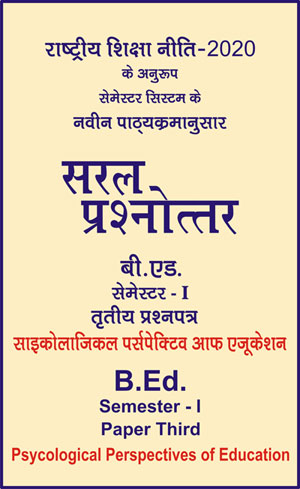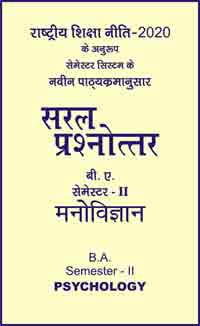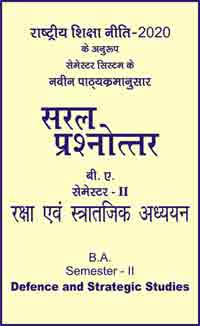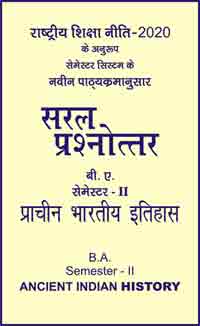|
बी एड - एम एड >> बी.एड. सेमेस्टर-1 प्रश्नपत्र-III - साइकोलाजिकल पर्सपेक्टिव आफ एजूकेशन बी.एड. सेमेस्टर-1 प्रश्नपत्र-III - साइकोलाजिकल पर्सपेक्टिव आफ एजूकेशनसरल प्रश्नोत्तर समूह
|
5 पाठक हैं |
|||||||
बी.एड. सेमेस्टर-1 प्रश्नपत्र-III - साइकोलाजिकल पर्सपेक्टिव आफ एजूकेशन (अंग्रेजी भाषा में)
Human Development
1. Child development is the study of :
(a) Pregnancy to Childhood
(b) Pregnancy to adolescence
(c) From pregnancy to life
(d) None of the above
2. There is a major difference between child psychology and child development :
(a) Study methods
(b) In the area
(c) Work
(d) None of the above
3. Child development is the study of :
(a) Different aspects of the development of children
(b) Children’s practices
(c) Elements that affect development
(d) All of the above three
4. Study of child development is important :
(a) For proper upbringing of children
(b) For the all-round development of children
(c) To control the behavior of children
(d) For the creation of good citizens
5. There is a difference between child psychology and developmental psychology :
(a) Area
(b) In purpose
(c) Approach
(d) All of these
6. Growth means :
(a) Growth of internal and external organs
(b) Enlargement of external organs only
(c) Growth of internal organs only
(d) Growing physically and mentally
7. Changes in development occur :
(a) Creative and destructive
(b) Creative
(c) Destructive
(d) Body
8. Areas of development :
(a) Body
(b) Mental
(c) Social
(d) All three
9. According to Harlock, infancy is :
(a) Two years from birth
(b) Two weeks from birth
(c) Two weeks from conception
(d) Two years from conception
10. Is infancy :
(a) State of adjustment
(b) A state of self-sufficiency
(c) Status of the problem
(d) Simulation stage
11. According to Harlock, the age of childhood is :
(a) 2 to 5 years
(b) Two weeks to two years
(c) Two to three years
(d) Two weeks to 1 year
12. Pre-childhood :
(a) State of subjugation
(b) Antecedent state
(c) State of sensitivity
(d) Dangerous state
13. Adolescence is a state that is almost :
(a) 12 to 20 years
(b) 13 to 21 years
(c) 16 to 18 years
(d) 12 to 18 years
14. How many teeth of children come out by the end of two years?
(a) 10 teeth
(b) 15 teeth
(c) 20 teeth
(d) 24 teeth
15. Pre-childhood :
(a) 2 to 5 years
(b) 2 to 6 years
(c) 3 to 5 years
(d) very much
16. Blood pressure occurs in infancy :
(a) less
(b) more
(c) very few
(d) very much
17. The most important factor in the physical development of children is :
(a) Exercise
(b) Cleanliness
(c) Nutrition
(d) Sleep
18. Increase in length has an impact :
(a) Pituitary gland
(b) Thyroid gland
(c) Clomax
(d) Reproductive gland
19. Girls acquire skills in wearing skills faster than boys because :
(a) They could easily do muscular combination due to their wrist being flexible.
(b) They are more proficient than children
(c) have a greater ability to learn
(d) They learn by imitation
20. Development of writing in children :
(a) One to two years of age
(b) two to three years
(c) 3 to 4 years
(d) 4 to 5 years
21. How many months can a child easily sit without support?
(a) 6 months
(b) 7 months
(c) 8 months
(d) 9 months
22. Micro functional skills fall under :
(a) catch
(b) writing
(c) drawing
(d) All of these
23. Who gave the expression of free expression the method of control of emotions?
(a) Rousseau
(b) Montessori
(c) Both (a) and (b)
(d) None of the three
24. How old is the condition of jealousy in children?
(a) 1 to 1 year
(b) 1 to 2 years
(c) 2 to 3 years
(d) 3 to 4 years
25. The emotions of children are related :
(a) Tangible goods
(b) Intangible objects
(c) Both tangible and intangible
(d) None of the above
26. Which of the following is more feared in adolescence :
(a) Animals
(b) People
(c) School
(d) Imaginary possibilities
27. Which emotion would be faster in adolescence :
(a) Anger
(b) Fear
(c) Love and affection
(d) None of these
28. The language development of a child takes place in childhood :
(a) at a rapid pace
(b) at a slow pace
(c) Both (a) and (b)
(d) Can not say
29. Imitation, affiliation and whose place is important in the language development of a child :
(a) Motivation
(b) intensity
(c) Purity
(d) Language
30. Child has an important role in social development :
(a) Family
(b) School
(c) Society
(d) All three
|
|||||














